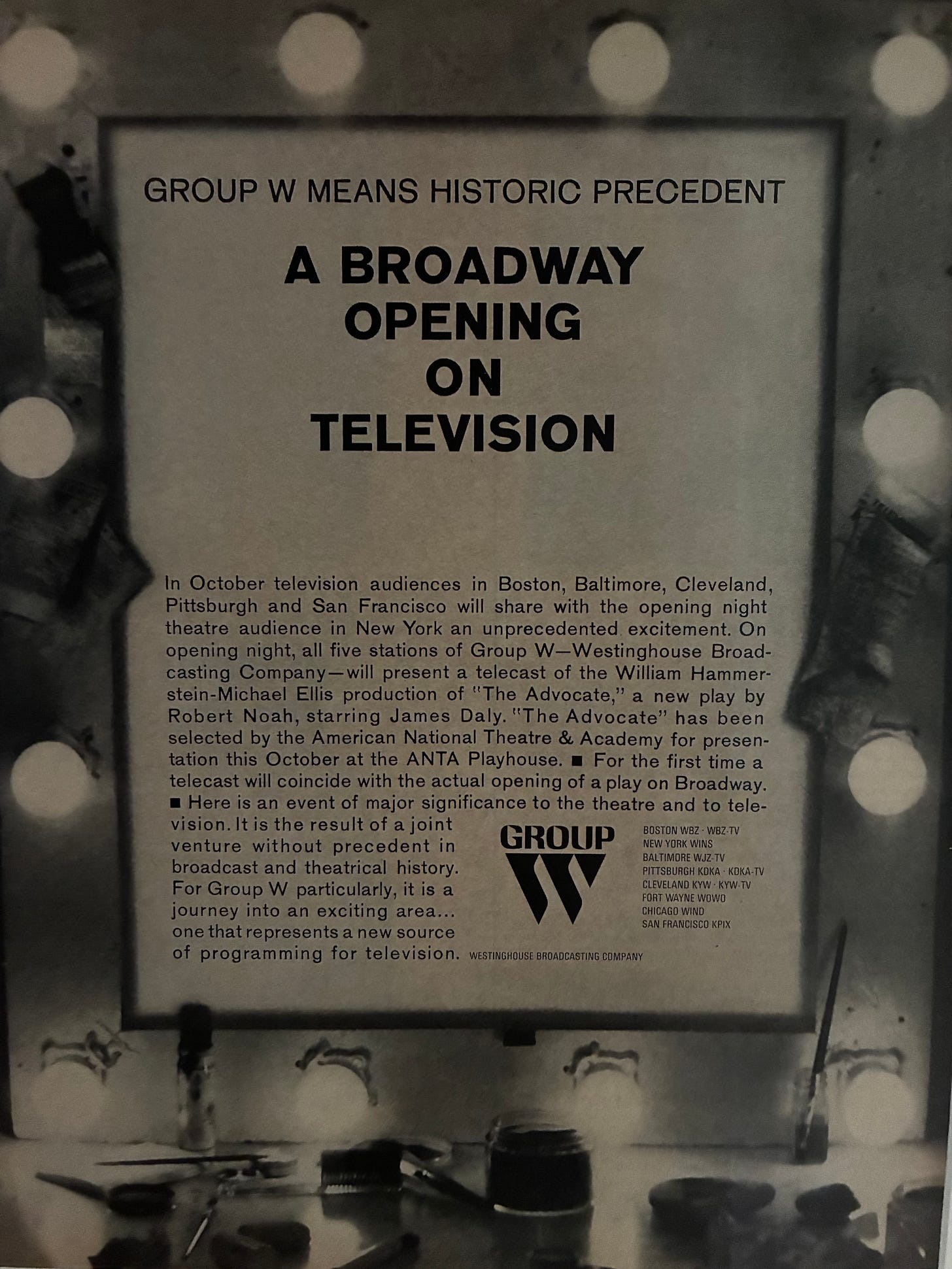A Short History of Broadway Simulcasts
Before "Goodnight and Good Luck" there was "The Advocate." This one's personal for me.
Move over, George Clooney.
Though a Broadway performance being broadcast live is a rarity, it’s not without precedent. The 2016 Broadway revival of She Loves Me streamed a live performance, and several productions—including South Pacific, The Light in the Piazza, and Contact—broadcast live on PBS via the series Live From Lincoln Center. Even as far back as 1961 a performance of Show Girl, starring Carol Channing, was broadcast live to Canadian pay TV.
—”How to Stream George Clooney’s ‘Good Night and Good Luck’ on CNN,” Playbill.
Forgive my pedantry, but the above capsule history misses a milestone that’s significant to Broadway history and to my family. On October 14, 1963, The Advocate, a play about the Sacco-Vanzetti case, opened at the ANTA Theatre, now the August Wilson Theater, and was broadcast simultaneously in five American cities by Group W, a small broadcast network owned by Westinghouse. The broadcast was not live but taped a few days in advance. It was the first time a play or musical was broadcast to an American audience during its Broadway run. The playwright was my father, the late Robert Noah.
As with Good Night and Good Luck, the airing of The Advocate was an event mixed up in the history of television during the 1950s. Clooney’s play has its origins in the McCarthy red scare and a CBS news commentator’s reply to it. Robert Noah’s play came about because my father had been caught up in the quiz-show scandals (he was executive producer of 21) and as a result became unemployable for a few years in television, starting a few months after I was born in 1958. In a bizarre coincidence, a contestant on the final episode of 21, which by then was no longer fixed, and from which my father had already departed, was my future father-in-law, Alan Williams, a book editor with an encyclopedic knowledge of history, literature, opera, and assorted other topics, although in this instance he didn’t win.
Before he became a TV producer Robert Noah was a writer of radio and TV plays, and during his exile he wrote The Advocate. It was produced at the Bucks County Theater, then a prestigious regional venue, and went on to Broadway with 60 percent of its financing put up by Westinghouse, which planned to broadcast a series of Broadway opening nights, but abandoned the idea after this one fizzled.
In retrospect, it makes much more sense to broadcast a play at the end of its run (as Clooney is doing, and also was done with She Loves Me) than at the beginning. In 1963 the theater world was feeling deeply beleaguered by the still relatively new phenomenon of television, and there were some complaints from theater veterans, including Billy Rose, that The Advocate’s precedent was the death knell for the Fabulous Invalid. (I can’t find the Billy Rose quote, but it was gratifyingly melodramatic.) In fact, it was the death knell only for The Advocate, which played one week on Broadway and then closed (due probably more to unfavorable reviews than to the simulcast, which was not seen in the New York metropolitan area).
The New York Times called the broadcast of The Advocate “a historic occurrence”:
The proceedings will be available simultaneously (and free of charge) to an estimated total of 7,500,000 television viewers in five major cities of the United States. True, what appears on the TV screens in Boston, Baltimore, Cleveland, Pittsburgh and San Francisco will be a taped version of the performance, recorded ten days before the opening. But the producers' contract with the Westinghouse Broadcasting Company (Group W stations) guarantees a word-for-word transmission, to coincide with what is being heard at the same time on the ANTA stage.
The Times said that the experiment was “being closely watched by the entertainment world … because the usual sources seem to have committed their pocketbooks almost exclusively to sex comedies and musicals.” Theater owners predicted that the arrangement, if it caught on, would hurt the sale of tickets to out-of-towners and national tours. The Advocate producer, Bucks County Playhouse proprietor Michael Ellis, replied that
Of the 7,500,000 persons to whom the telecast will be available, I'm sure not more than 100,000 to 150,000 have ever seen a professional show, and it would be generous to estimate that even half of these would come to New York and that even a tenth of that half would go to see a play of this kind. That's a drop in the bucket…. [As for national tours] those audiences will have been stimulated by the TV show and will want to see the 'live' play. After all, big theatrical successes like 'The Miracle Worker' and ‘A Visit to a Small Planet' were first seen on television, then became Broadway hits, were made into films and are still going strong in stock. So you see, the only law is, 'Sometimes it works, sometimes it doesn't.’
Opening night sold out, and a representative of Westinghouse estimated that “at any given moment more than 2,000,000 viewers were watching the show.” According to a follow-up in the Times, the play was well-received by television audiences. "I never saw anything like it," said a spokesman for station KYW in Cleveland, noting 41 viewers had called in to praise the program. "People just don't call in that number with compliments." The Times said “There was general agreement among viewers that the play was a welcome relief from domestic comedies, cowboys and hospital corridors.”
But if sometimes it works and sometimes it doesn’t, in this instance it didn’t. The Advocate closed on October 19, five days after it opened, and my father went back to TV, taking a job producing game shows for Goodson-Todman Productions.


